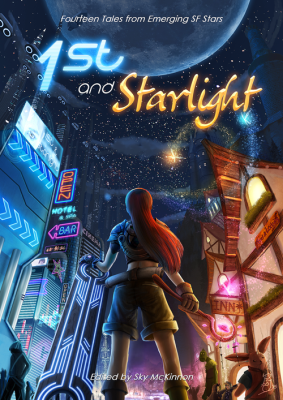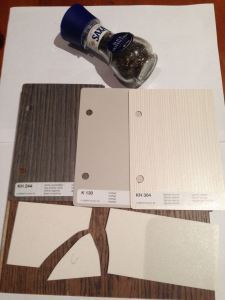Fi Michell's Blog
May 31, 2016
Since I’m not updating regularly, this blog has become a ...
Since I’m not updating regularly, this blog has become a static site. If you’d like to contact me, my address is on the About page and my writing history is in the Bibliography. At the moment, I’m working on a novel.


July 28, 2015
1st and Starlight – Released!
Future Finalists presents 1st & Starlight, their very first compilation of science fiction and fantasy. Future Finalists is a group of authors that have previously placed in the top 8 for at least one quarter of the Writers of the Future Contest, some of whom have already gone on to become winners.
Fourteen of these authors now contribute their strongest voices, offering glimpses of every corner of the genre–from contemporary to high fantasy, from hard science fiction to the wildly experimental, the whole breadth of possibilities of speculative fiction are showcased here.
Experience modern twists on fairy tale classics, extraordinary aliens and magical creatures. Heroes and heroines no matter how big or small (or inanimate!). Adventures across time and space and deep within the human mind. From great triumph to the little victories that make us up, the thing these stories have in common is their greatness, and their enormous heart.
Containing my story, “Shoeless”, and many others – see Previous post: 1st & Starlight


July 14, 2015
1st and Starlight
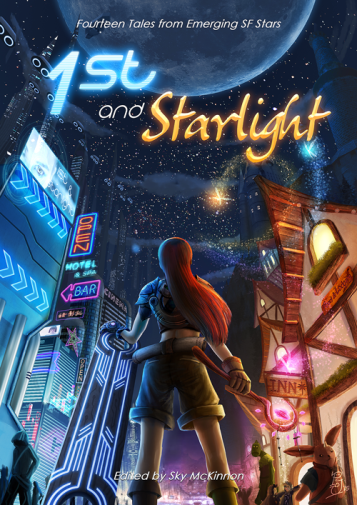 1st and Starlight, an anthology of fantasy and science fiction short stories, will be released on Amazon in the next few days, including my story, “Shoeless”. I’m thrilled to share the table of contents with my wonderful author friends: Jennifer Campbell-Hicks, (then myself), Rebecca Birch, Kary English, Holly Heisey, Julie Frost, William Wood, Robert Finegold, Dustin Adams, Frank Dutkiewicz, Sean Monaghan, Stephanie Lorée, Scott Parkin, and Sky McKinnon, who also did a superb job editing the project.
1st and Starlight, an anthology of fantasy and science fiction short stories, will be released on Amazon in the next few days, including my story, “Shoeless”. I’m thrilled to share the table of contents with my wonderful author friends: Jennifer Campbell-Hicks, (then myself), Rebecca Birch, Kary English, Holly Heisey, Julie Frost, William Wood, Robert Finegold, Dustin Adams, Frank Dutkiewicz, Sean Monaghan, Stephanie Lorée, Scott Parkin, and Sky McKinnon, who also did a superb job editing the project.
All of us have been finalists in the Writers of the Future contest, and some have gone on to win. This anthology is our own, however, and in no way affiliated with the contest.
I’m looking forward to sharing a link to the anthology on Amazon as soon as it is out.
A quick note about the large lapse in this blog:
I’m caught up renovating my house, which has gone on much longer than expected – as these projects often do. It looks like it will take another few months to complete. My writing has taken a huge hit, and I’ve even neglected submitting. This will change…I’m not giving up!…but in the meantime, it’s fun to have this anthology arrive.
Eventually, I plan to change this blog to a more static format (still with comments enabled). I’ll post when I have some publishing or writing competition news. To keep up with my friends, fellow writers and various publishers, I’m active on Facebook and Twitter. I should be more active once the renovation is done!


September 2, 2014
“The Kyne Extraction” at Kasma Science Fiction
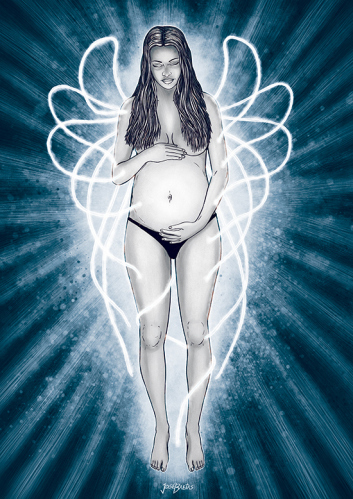 This beautiful illustration is by José Baetas for my story, “The Kyne Extraction”, this month’s story online at Kasma SF. The story is short, and it’s free to read.
This beautiful illustration is by José Baetas for my story, “The Kyne Extraction”, this month’s story online at Kasma SF. The story is short, and it’s free to read.
If you haven’t already, it’s worth checking out Kasma SF’s other stories while you are there. Last month’s story, “Pink Ice in the Jovian Rings” by C J Paget, is a fabulous tale I first read in the excellent Anywhere But Earth anthology edited by Keith Stevenson, where it was one of my favourites. And that is but one of many fine stories and authors to choose amongst. I’m thrilled to have my story keep them company.


August 7, 2014
Space to Write
People who write have to allocate time and space in order to do so. (Obviously.) If you wait for the time and space to happen by itself, it usually won’t, or it will be taken over by a myriad of other possible activities.
For me, space to write is a matter of focus. I can write at any available time and anywhere, but I need to be able to focus to write anything decent and, especially, a crappy first draft. So finding a space and time in which to write is really an ability to find a way to attain that focus.
In a practical sense, I can write equally in a quiet room or in a noisy cafe where the noise blends so nothing in particular stands out. I can’t write in a room where my kids will often interrupt me.
Some people like to find a special place where the ritual of settling into their surroundings helps them to sink into their writing. In my constantly changing environment (changing people around me, no dedicated writing room, a constantly changing timetable that bends with family demands) I write anywhere. Inside or outside, at home or not. My laptop is my room. My awareness sinks into the screen. I don’t notice my surroundings unless something or someone specifically intrudes – or unless I get stuck and begin to procrastinate.
But my biggest hurdle is other projects that also require focus. When I focus on a story, it plays in my mind even when I’m not at my laptop. While I’m making dinner for the kids, I might be running through a scene in my head. Definitely, while I’m driving somewhere familiar. Lately though, because we are embarking on a renovation, I’ve been doing the same thing with the design of my house. This is falling back into an old pattern for me, since I used to be an architect. So all that focus on writing has been consumed by this other project.
Right now, for me, finding space to write is about finding the space in my head to hold multiple creative projects. To do one well, the other sometimes has to take a back seat. My renovation is finite, but will be ongoing until at least the end of May next year. Somehow, in the midst of that, I hope I can maintain a space where I can write, even if I can’t use it as much as I’d like.
(In the meantime, I can at least keep my submissions up. And I have a recent acceptance going online next month.)
Do you prefer a special place to find your focus, or do you find the right conditions in many places? Do you give up or do you keep writing when your primary focus is demanded elsewhere?


June 9, 2014
Submitting, Trunking and The Sword of Damocles
It’s been while since I’ve posted, but today I thought I would, just to let the internet know I still exist. Life has been hectic (normal for most of us) and when I’ve had time to write, I’ve been focussing on my stories rather than my blog posts, especially since there’s been little news of any kind this year.
Why is that? Well, I sold most of the stories I had circulating up until now, except for a couple I’ve decided to trunk. One of those, I still like, and I may brush it off and deal with the ending that I think is the problem in due course. Maybe it would make a good competition entry if I have a tight timeframe…which could be the case later this year. The other one…well…there’s something about it that I don’t like, and I think I’d rather not have it published as it is. I wasn’t unhappy to receive its latest rejection. Rather, the time out had made me comfortable with the idea of trunking it for now.
This year, my submission rate has dropped. Partly because I’ve worked on several longer stories (which have less chance of selling due to their length), and so far only one is in final submittable condition. Those that remain on submission are stories I’m happy to have out there, and I hope they find homes. Some of the responses are taking a long time. One of the hazards of having my writing improve is that stories get to second and final round status more frequently, which means replies take longer to arrive. That’s okay. I stop thinking about submission results and just get on with writing my stories.
The Sword of Damocles
Right now, I have a huge obstacle in the way of my writing – a major house renovation. Something that I should also take maximum enjoyment in tackling, since this is my one chance in the next two decades to do this and hopefully get it as right as I am capable of doing.
I used to be an architect, and though I’ve been away from that for a long time now, I’m finding myself sucked into every detail of finish and fixture. My reading has become focussed on specification documents and fabrication pdfs – it’s amazing the tiny details you find tucked away in these that are not in their sales documents.
An example: last weekend, my husband and I drove an hour to a stone warehouse to see a brand new material suitable for kitchen counters. This stuff is amazing: you can put a blow torch on it and it won’t burn; you can pour acid on it and it won’t etch; you can strike it with a chisel and it won’t chip. That’s what we need, we thought, something we don’t need to think about, that we can’t possibly destroy. Something I can let my kids cook on without nagging them to be careful all the time.
We were keen for this to work. Very keen.
But, like superheroes, every material, no matter how fantastic, has its weakness.
Everything we left on this ceramic came off as advertised – unlike a piece of sealed, honed marble we loved, which we destroyed with the same combination of tests overnight: balsamic vinegar, coffee, red wine, oil, turmeric. Unlike even engineered quartz, where something (try turmeric) always seems to leave a faint impression on the resin.
Then I rapped the marble with the end of a glass supermarket pepper grinder. It made three pits. “Watch this!” I said to my husband, and imitated the advertisement for the ceramic by striking it with the grinder, not nearly as hard as I’d seen demonstrated with a chisel. It didn’t chip at all. Not at all.
It shattered into three pieces.
We told ourselves the real thing would be much thicker than our sample, and it would be okay. Then, in a moment of obsession, I read the fabrication manual. Right at the very end: do not hit with blunt, heavy objects or the material may chip or shatter.
Oh.
No qualification based on the thickness of the ceramic, either.
And my kitchen is filled with blunt, heavy objects. Can I guarantee I won’t hit my bench with one in the next three years, let alone twenty?
To us, this was the sword of Damocles, waiting to fall on our bench.
So much for wonderful new materials!


March 13, 2014
Writing to Failure
The topic of failure rears up from time to time. Something we all face, yet can often try to hide, often I think due to that insidious demon: a sense of shame. Yet, without being willing to fail, we won’t get very far. Every writer has to deal with many kinds of rejection, whether from colleagues giving hard critiques, disappointing course grades, slush readers and editors continually rebuffing our stories, or even negative reader reviews after publication.
I hear people talk about taking risks with writing. I’m often not sure exactly what they mean. For some of us, the risk is simply that our attempt at a story will be horrible. That we won’t finish, or that those we show it to will hate it; that we’ll be laughed at.
Shortly after one of my stories was published – one I was very proud of – I dreamed I became a famous writer–famous for the worst story ever. Everywhere I went, I overheard my name and people talking about my story. But they were laughing at it, saying how very, very terrible it was. Pretty funny, when I woke up, but still!
A friend of mine was told by an instructor that her writing was too ambitious. This made me mad. How could anyone trying to learn to write be “too ambitious”? Aren’t learning institutions places to explore? Maybe she didn’t succeed in what she tried to do, but the point is she tried, and learned from that. Which brings me to the idea of writing to failure.
When I lift weights, I can’t improve unless I lift them to failure – that point where my muscles can’t take any more. If I just lift little weights, the benefit isn’t there. I have to lift heavy weights that get harder as I get more experienced – it never gets easy.
I think writing is the same. We will never learn to write an ambitious story unless we stuff up attempts along the way. We may never even learn the basics. But every story is a chance to learn, whether it works out or not.
Play with plot, play with language, make many, many mistakes. If you love beautiful, lush, evocative prose and attempt it, you may first begin producing very purple writing. But you won’t arrive at those exquisite, crisp images that you love unless you start somewhere. Or, say you’re inspired to want to write like Salman Rushdie, your early attempts may be unintelligible. But you have to feel and learn your way there somehow. And you’ll end up finding your own voice along the way.
If we have fun, wrestle with our words, hear feedback from others without feeling the need to be ashamed, then we can take on board what we need and grow. Not easy sometimes, because of that shame that’s programmed into many of us through the education system from a young age – always being scored, getting good grades being something to be proud of. Attempts that don’t score being covered in red ink, becoming something to hide, rather than celebrated.
Perseverance is working through the pain of failure to get to a goal we have may no guarantee of attaining. So that ‘failure’ is nothing to be ashamed of – it’s just part of the process. Getting up and continuing on, is something to be admired. And, if you decide it’s not for you, that it’s not worth it–there’s no shame in that, either. You’ve tried and learned something about yourself, and are likely richer for it. That’s part of being human.


March 10, 2014
Writing News for March
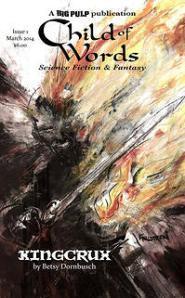 This month brings the release of Big Pulp’s new bi-annual magazine of science fiction and fantasy, Child of Words. I’m pleased to have my short story, Attila’s Throne included in the inaugural issue, and I’m looking forward to receiving my copy and reading the rest of the stories.
This month brings the release of Big Pulp’s new bi-annual magazine of science fiction and fantasy, Child of Words. I’m pleased to have my short story, Attila’s Throne included in the inaugural issue, and I’m looking forward to receiving my copy and reading the rest of the stories.
At best, a Big Pulp story is smart, literate, and thought-provoking. It’s got attitude, rarely takes itself too seriously, and isn’t afraid to poke where it doesn’t belong. It defies expectations and tropes. It hits you where you live and sometimes in the nuts. A Big Pulp story is sci-fi, it’s fantasy, it’s mystery. It’s horror and romance. Sometimes it’s all of those things at once, and it’s rarely what you expect.
Big Pulp is also running an Indiegogo campaign from March 3 to April 20, 2014, to help with the costs of running their website and publishing. This is probably the best way right now to order a copy of one of their magazines, whether print or ebook.
The state of my writing today…
Well, it’s been a difficult year so far, in terms of getting things written, and it’s going to be even more challenging, coming up, because I’m going to be renovating my home. However, I did manage a 7500 word draft of a new story, which is almost ready for feedback. Also, I’ve put time into an ongoing collaborative children’s book project. However, I’ve been away a couple of weekends, plus a week with the family, plus had the kids on holidays until not very long ago, so I feel as though I’ve been pushing to get new stuff done. And I’ve finally had to catch up on a mountain of paperwork that’s become unavoidable.
Times like this, I just try to keep plugging away. The deck will eventually be cleared, even if it takes months. Post-renovation, the house will be easier to write in – I’ll have my own space! The worst thing now would be to give up and stop, and lose my fluency. So even the odd writing exercise just to keep things fresh is good. Marketable work isn’t always everything. I think it will help to just keep things going by writing for fun.


February 13, 2014
‘The New Gothic’ is released
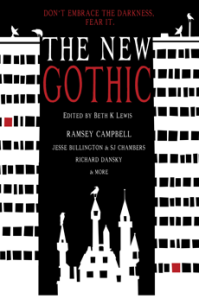 I’m happy to say Stone Skin Press has released The New Gothic, an anthology of twelve chilling tales by a host of outstanding authors, edited by Beth K Lewis. It includes my story, “The Debt Collector”.
I’m happy to say Stone Skin Press has released The New Gothic, an anthology of twelve chilling tales by a host of outstanding authors, edited by Beth K Lewis. It includes my story, “The Debt Collector”.
There’s a rather wonderful review of the collection at Popcults which hints at some of the contents and concludes: “…within this mix I could see that this collection was Gothic done right.”
I have to thank Cape Rust, the author of the review, for the laugh when I read the last line.
Here’s a preview from the opening story, “Dive in Me“ by S J Chambers and Jesse Bullington, a tale which refused to let me go until the end and then some.
And the opening from my contribution, “The Debt Collector“, set in a very different time and place, showing the breadth of this collection.
The New Gothic is available in both quality paperback and e-book formats, online and in UK book stores.


January 12, 2014
A Trivial Post: Mixing Surf and Sunglasses
 So I was sitting at the beach, broiling in the sun yet completely comfortable reading my Kindle, and marvelling yet again at how great my sunglasses were, how they were one of the few bought things that actually made me happy just because they were utterly effective. The thick, dark brown plastic arms shielded my eyes from glare at the sides; the large, dark, polarised lenses meant I never had to squint no matter how intense the sun. Shamelessly expensive, yet I’d replaced them two years back with an identical pair when I’d broken them.
So I was sitting at the beach, broiling in the sun yet completely comfortable reading my Kindle, and marvelling yet again at how great my sunglasses were, how they were one of the few bought things that actually made me happy just because they were utterly effective. The thick, dark brown plastic arms shielded my eyes from glare at the sides; the large, dark, polarised lenses meant I never had to squint no matter how intense the sun. Shamelessly expensive, yet I’d replaced them two years back with an identical pair when I’d broken them.
But it was getting hot–hot enough to cool off in the ocean. The kids were bouncing around in the surf, having fun. I decided to go and stick my feet in up to my ankles.
It was like dipping my feet into a bath full of ice cubes, but after a minute, not too bad. Little waves kept splashing higher, and since I was getting wet anyway, I went in to my knees. My seven-year-old daughter joined me, laughing at me wincing at the cold which wasn’t bothering her in the slightest, and I stayed there for her sake instead of retreating.
Knee-deep, the waves were bigger, breaking on my thighs, so pretty soon I gave up keeping my legs dry and wandered in further, no longer feeling the temperature where I was submerged at all. Because I was still trying to protect my stomach from the cold shock, I began jumping the waves like the kids were. It didn’t work–soon the waves were smacking me in the shoulders, spraying onto my face. But it was fun.
My nearly-ten-year-old son swam over, looking pleased. He’d rarely seen me in the ocean before–the day had to be stinking hot to entice me. I let myself go in further with him. It felt good.
Ahead, people were diving under the waves. I remembered that: the calmer water low down, the turbulence passing over me; surfacing not knowing if there was a second or multiple waves hidden and rising behind, or if the water would be calm, and breathing possible. Surprisingly, diving tempted me, though I needed to be a bit further out to try. But I had my beloved sunglasses on because I hadn’t planned on going in so far.
I could go back to the beach, leave the sunglasses with my bag and towel, then come back in and dive without risking them.
No. I wouldn’t be diving under any waves. I never did that these days.
My son was jumping, the break knocking him back meters each time.
I asked him, “Have you ever dived under?”
He hadn’t. The idea was a bit scary.
“It’s calmer underneath,” I told him. “Don’t do it till you’re ready, but see–all those people are diving.”
One day, I thought, someone should really show him how.
By now waves were smacking me in the head and my hair was drenched. I felt great–not cold at all. I’d been tugged out further than I realised, past my waist, and as I turned from my son to see the next wave, I jumped, but not high enough and the crest broke on my face. When my feet found sand again, I touched my sunglasses. Would the hinges rust? Ah well, I’d rinse and dry the salt off.
It looked so much fun, diving under. But I shouldn’t unless I went back to the beach first to put my sunglasses down. But then I’d be out of the water, and what if I decided not to go back in? This felt fantastic; I hadn’t done it for years, and I didn’t want it to end yet. And look at the kids–how often did I keep them company in the sea? A shame to spoil things just to put my sunglasses back with my towel.
The next wave looked big.
Very big, and no one, but no one, was jumping it. Everyone was diving. My son had swum away, where he felt safer. Oh what the hell – I had no choice. I dived beneath the oncoming monolith.
The water rushed over my head and shoulders and back, wonderfully rough and soft at the same time. Near the sea bed, the flow was smooth and quiet as I remembered, the sound of crashing water dulled, the screams and laughter of the crowd gone for seconds that felt longer than they really were. I angled up and broke the surface; the wave and most of its foam were behind me, drenched people before me, another wave was rising a few metres ahead. I checked for my sunglasses. Still there.
Great! They stayed on in the water! My son swam behind me, looking excited.
“See,” I called to him, “this is how you do it.”
And I dived again, under the next wave. Just as fabulous. Then I dived the next.
This wave was stronger, more turbulent. There was a light tug across my eyes; my fingers told me my sunglasses were gone. I surfaced and found myself surrounded by an opaque ocean churned golden with sand, flecked white with foam lace; another wave already rising. My sunglasses would be swirling in the current below, borne metres away; no hope of finding them. And it wouldn’t be safe to try. I couldn’t leave my son out this far on his own.
I’d been stupid, wearing those sunglasses in. Twice as stupid, not returning them to the beach. I’d underestimated the waves’ temptation–foolishly imagined they wouldn’t tempt me at all. Instead, I’d found myself tempted as much as I had been decades ago.
I had a choice. I could give in to the swell of disappointment. Or I could say, stuff it, acknowledge I’d been an idiot, and then just keep on enjoying the surf.
The surf won.



